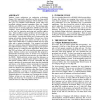Free Online Productivity Tools
i2Speak
i2Symbol
i2OCR
iTex2Img
iWeb2Print
iWeb2Shot
i2Type
iPdf2Split
iPdf2Merge
i2Bopomofo
i2Arabic
i2Style
i2Image
i2PDF
iLatex2Rtf
Sci2ools
SIGMOD
2004
ACM
2004
ACM
The Next Database Revolution
Database system architectures are undergoing revolutionary changes. Most importantly, algorithms and data are being unified by integrating programming languages with the database system. This gives an extensible object-relational system where nonprocedural relational operators manipulate object sets. Coupled with this, each DBMS is now a web service. This has huge implications for how we structure applications. DBMSs are now object containers. Queues are the first objects to be added. These queues are the basis for transaction processing and workflow applications. Future workflow systems are likely to be built on this core. Data cubes and online analytic processing are now baked into most DBMSs. Beyond that, DBMSs have a framework for data mining and machine learning algorithms. Decision trees, Bayes nets, clustering, and time series analysis are built in; new algorithms can be added. There is a rebirth of column stores for sparse tables and to optimize bandwidth. Text, temporal, and ...
| Added | 08 Dec 2009 |
| Updated | 08 Dec 2009 |
| Type | Conference |
| Year | 2004 |
| Where | SIGMOD |
| Authors | Jim Gray |
Comments (0)

